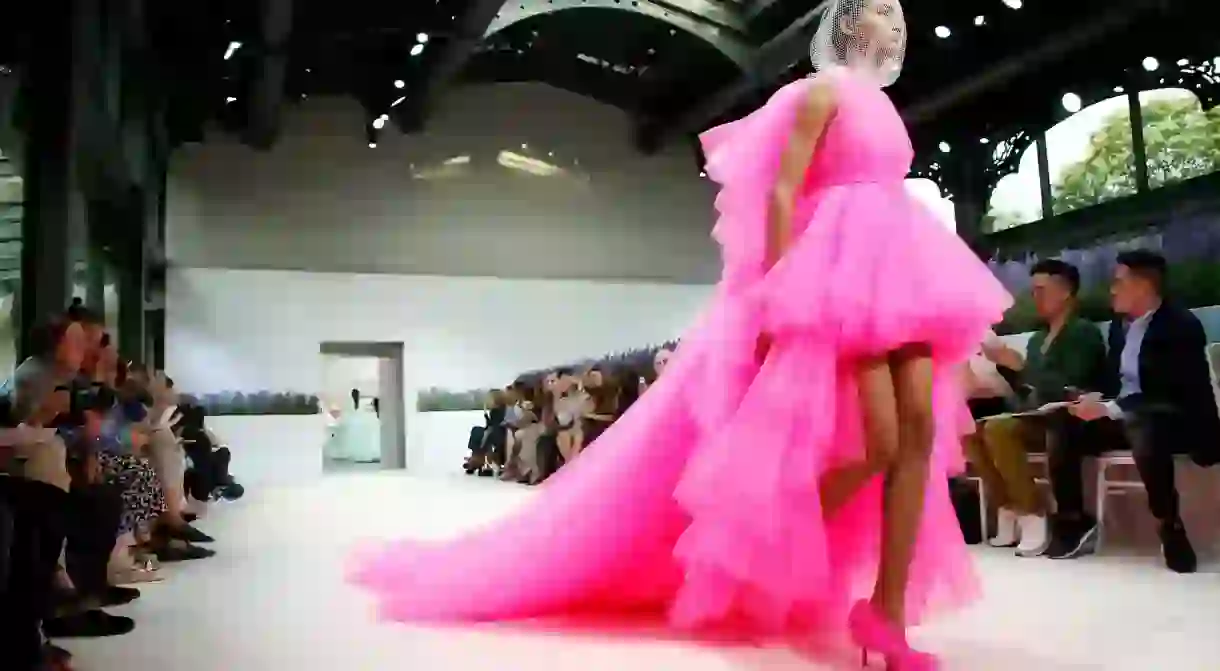New York Designers Ponder the Power of Pink

From the 19th century’s feminization of color to the destabilizing power of millennial pink, the cultural significance of this hue depends heavily on its social and historical context.
Cultural attitudes towards the color pink touch on issues of gender, power and protest. These are just some of the themes explored in a new exhibit, Pink: The History of a Punk, Pretty, Powerful Color at the Museum at FIT, located on the campus of the Fashion Institute of Technology in Manhattan’s garment district.

Fashion historian Dr Valerie Steele curated the exhibit, which features approximately 80 garments dating from the 18th century to the present. Designers featured in the exhibit include Elsa Schiaparelli and Yves Saint Laurent, whose work is synonymous with the shade. The avant-garde Rei Kawakubo also makes an appearance, along with looks associated with hip-hop and punk rock as well as the pink pussy hats created for the 2017 Women’s March in Washington DC. This extensive line-up underscores the breadth of provocations associated with the color pink, and how people beyond the fashion industry react to its significance.

“I am drawn to the color pink. I love its fleshy soft ways and feminine blush essence,” says Lindsay Jones, head designer and owner of the New York label Músed, alluding to the yonic symbolism the color evokes. “It’s disarming with softness,” she continues, “a reminder of the magic of our most sacred parts.”
It wasn’t until the 19th century, when European and American men claimed darker colors like navy and black associated with war uniforms, that the more pastel hues became feminized, notes Steele in an audio guide to the FIT exhibit.

Brian Michael, head designer and owner of the New York house Whatever 21, says, “I think pink can be really subversive, which is why I like it; it’s my favorite color. You’re gonna see a lot of pink in my new collection [for spring/summer 2019]. I’m juxtaposing pink with elements of Goth streetwear and bondage gear.” The designer, whose collections are always gender fluid and non-binary, notes that he is drawn to pink to “subvert stereotypical masculine elements of clothes.” Michael adds that he likes to challenge his audience – many of whom are streetwear hypebeasts into hip-hop and nightlife – to rethink socially constructed notions around gender and fashion.

“Lil Peep is my ultimate style icon. His passing last year inspired me to incorporate pink into my [spring/summer 2019] collection,” says Michael. Cam’ron is another of the designer’s muses. “Artists like Cam’ron, really heavy into the hip-hop world that’s steeped in toxic masculinity and homophobia, took risks by wearing pink. [Cam’ron] wore it and made you think about what a rapper could look like.”

Sarah Lathrop, head designer and owner of the New York brand Sext Pixels, notes that beyond gender, nationality can shape your attitude to the color pink. “Americans tend to wear a lot of black,” she says. “Pink isn’t as big here as it is in Tokyo.” The FIT exhibition examines pink in “a global context,” looking at Western and non-Western attitudes to the color. A press release for Pink: The History of a Punk, Pretty, Powerful Color calls attention to the Diana Vreeland quote “Pink is the navy blue of India.” The exhibit explores Mexico’s embrace of rosa mexicana as a marker of national identity.

Lathrop is also attracted to pink for aesthetic purposes. “As a designer, pink seems like the prettiest color,” she says, qualifying her use of the hue in her work. She does admit that pink also carries with it emotional baggage. “When I was younger, I was teased when I wore a pink sweater. Some people are scared of pink.” In press material for the FIT exhibit, Steele suggests that because eroticized parts of the body like the mouth, genitals and nipples on people with light skin are known as “pink parts,” the color carries erotic connotations.
AnnaLiisa Benston, a New York artist known as Famous on Mars, and whose work consists largely of reconstructed garments that challenge fashion-industry hegemony, says, “Pink is powerful. I use it in my work a lot; it’s attractive. Pink is not purely femme, or for any one gender – it moves fluidly through history in design and fashion.”
With the power to provoke and enchant, the color pink has its share of admirers and critics. However, as the above reflections remind us, the true power of a color lies in the cultures that ascribe meaning to it.













